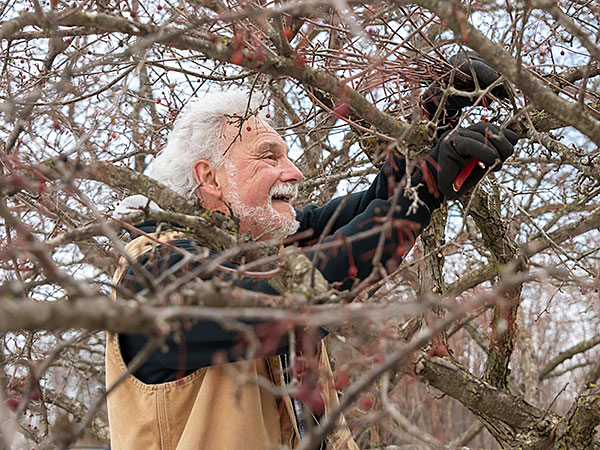
Watch weather conditions for an appropriate window of time to spray fruit trees or large deciduous trees with dormant oil. Spray if aphids, scale, or mites were a problem in the past. Temperatures must be at least 40 degrees Fahrenheit with no chance of freezing or rain within the following 24 hours. Avoid spraying on a windy day. Certain trees have a phototoxicity to dormant oil and should not be sprayed. A few common ones are arborvitae, beech, red maple, Japanese maple, sugar maple smokebush, blue spruce, blue cultivars of juniper, and yew. Call Plant Information if in doubt.
To reduce the spread of oak wilt, all oak pruning should be completed in March, or before the oaks begin active growth. Pruning should not resume until after the first frost, or around November 1.
Prune fruit trees in early March on a dry day before buds swell. As with all pruning chores, sterilize pruning tools with a 10 percent solution of bleach before each cut. Prune out sucker growth, water sprouts, and any diseased or dead branches. Remove crossing branches, rubbing branches, or those that grow toward the center or the plant rather than outward, away from the interior. Fruit trees benefit from having their canopies opened up to permit more sunlight and air into their centers.
Prune spring-flowering trees and shrubs immediately after they flower to preserve this season’s flower display.
Prune roses when the forsythia begins to bloom. When pruning roses, make a 45-degree cut above a healthy bud, angled away from the center of the plant. If not done last fall, prune hybrid tea roses and grandiflora roses back to 12 inches to reinvigorate growth. Prune out dried, darkened, and broken canes and any dead tips. Prune shrub roses to remove dead wood and very lightly to shape to size.
Fertilize woody plants four to six weeks before they begin new growth only if they have shown signs that they could use it. These would include poor leaf color, failure to completely fruit or flower, or stunted growth. Use a slow-release granular fertilizer or an organic product and water in well. Do not fertilize newly planted trees or shrubs. Wait one year before making this application.
Plant trees and shrubs before they break bud and when soil conditions permit. If spring weather is unusually wet, consider planting in the fall when the plants begin their dormancy. With all woody plants, avoid planting too deep. Research indicates that more trees suffer from being planted too deep in the hole than any other problem. Plant with one-third of the root ball above ground. Taper soil away from the trunk back to ground level. Mulch the entire root zone with several inches of shredded or chipped bark.

